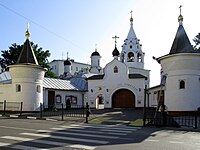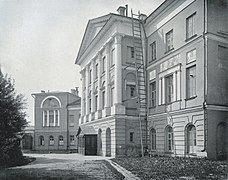Goncharnaya Street
The Goncharnaya Street (1922-1992 Wolodarskowo Street ) is a street in the district Tagansky in the Central Administrative District of Moscow . It leads from Großer Watin-Gasse to Taganskaya Square.
history
The street got its name after Goncharnaja Sloboda , a "pottery settlement", a part of the city where potters lived and worked. The chronicles show that in the 16th century, ceramic production was moved from the Kremlin , where it had been since the end of the 12th century, to the Schwivaya hill across the Jausa River. Between 1947 and 1948, a pottery workshop was opened in a high-rise building on Kotelnicheskaya embankment. There was also a settlement of gunsmiths . Their graves were found during the restoration of the temple of Nikita the Martyr.
Since the 18th century the Goncharnaya Sloboda area was built up of noble houses and merchants' houses. In 1812, a fire destroyed the street that was practically in the center of the fire, but the old 17th century walls survived the fire and are preserved at the foot of the houses that were restored in the first half of the 19th century. In 1922 it was renamed Volodarskovo Street in memory of the revolutionary V. Volodarsky .
The 1935 general plan for the reconstruction of Moscow called for the complete demolition of the buildings in the Tagansky district. Goncharnaya Street was to become a wide, radial main street, with buildings in the style of Stalinist classicism. This plan was not implemented, with the exception of the Stalinist houses No. 26 to 32 and 36 to 38. During the construction of the Bolshoi Krasnocholmsky Bridge in 1938, only the southeastern quarter along Goncharnaya Street, including the Church of the Resurrection in Goncharny Proezd, a church from 1649 with a three-tent roof, was demolished. The church of the martyr Nikita was looted and restored by Lev David after the war. After the war, the original plan was changed: the Stalinskaya Wysotka residential building was built at the foot of the Schwivaya hill , which separates the street from the bank of the Moscow River .
description
The Goncharnaja Street is about 900 meters long and is a very quiet street, the current street scene mostly from the 19th century.
- House number 6 - Afonskoje Podworje with the church of St. Nikita an der Jausa - now Podworje ( Metochi ) of the Rossikon monastery . The church was built in 1595, the bell tower 1684–1685, and the ensemble developed by the end of the 19th century. Under Soviet rule, the church was closed for services in 1936 and used as a storage room until 1990. Wall and towers were torn down. At first the demolition of the church was planned, but the resistance from the population saved the church. In 1991 the Church of St. Nikita was returned to the Russian Orthodox Church. In 1996 the wall and towers were rebuilt.
- House number 11 - The Tutolmin manor . The three-story house was built at the end of the 18th century in the classicism style for the merchant Surovshchikov, after which General and Senator Timofei Tytolmin bought the house and rebuilt it. It burned down in 1812 and remained unfinished for a long time until the merchant Timofei Prokhorov, who opened a factory school here, became its owner. Factory production existed until 1850, after which the building was used as a tenement house. At the beginning of the 20th century there was a private women's high school; According to the order of the client E. Konstan, one floor was built by the architect W. Scherwood, and the originally existing wings were also rebuilt. Another floor was added in the 1930s. Since 2015, after an invest bank moved from there, the five-story building has belonged to the Institute of Philosophy of the Russian Academy of Sciences .
- House number 14-16 - Klapovskaya manor - a cultural object of federal importance , is a listed building. In the bottom of the house there are palaces from the 17th century. In the 18th century and 1816-1823 it was overbuilt. The house is open to visitors twice a year (April 18, Monument Protection Day and May 18, International Museum Day ). The ensemble of the mansion consists of a main house and two outbuildings, there is also a fence with a wrought iron grating and two gates from 1820.
- House number 2 - Milgausen house from the 18th to the beginning of the 19th century
- House number 29/7 Church of the Assumption of Our Lady in Gontschary from 1654, bell tower from 1764–1774. It was never closed to church services under Soviet rule and kept all its bells. A metochi of the Bulgarian Orthodox Church has been located here since 1948 . Bulgarians are among the parishioners of the Church.
- House number 35/5 - Seljin Bezsonowa House from the 1830s, still a cultural object of federal importance
- House number 26 - a residential building in the style of Stalinist classicism built by Lev Rudnew in 1950–1957. Well-known military leaders lived here - General Ivan Fedyuninsky , General Ivan Sukhov, General Alexander Luchinsky , marshals of the aviators Grigory Vorosheikin and Phillip Agaltsov, as well as writers and artists. There are a number of plaques on the facade.
- House number 38 - a monumental fourteen-story residential building with a colonnade, sculptures and arches, also in the style of Stalinist classicism. Architect - N. Vishnevsky and G. Vorobyov. The building was constructed according to the plan of the reconstruction of Goncharnaya Street in 1935. Its central corps was set up in 1936–1939 for the People's Commissariat for Defense and was somewhat damaged by German air raids during the war. Both wings were built by German prisoners of war in 1946.
On 3/1 Goncharnaya Street there is a private museum with Russian icons, a collection of more than 5000 exhibits. Near Goncharnaya Street on Fifth Kotelnichesky Alley is the Cold War Museum ( Bunker GO-42 ).
The closest metro station is Taganskaya .












